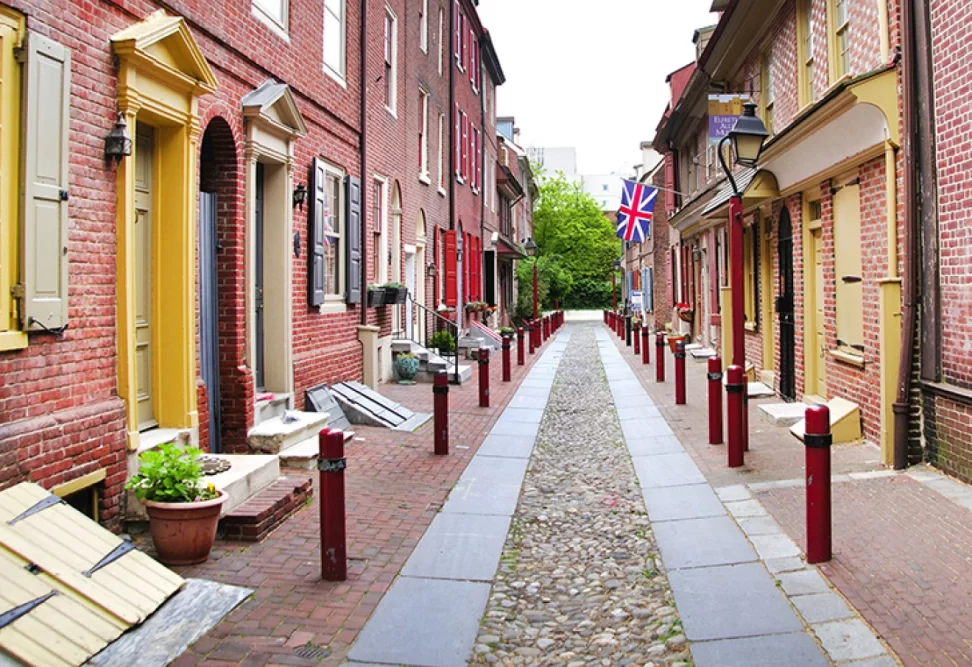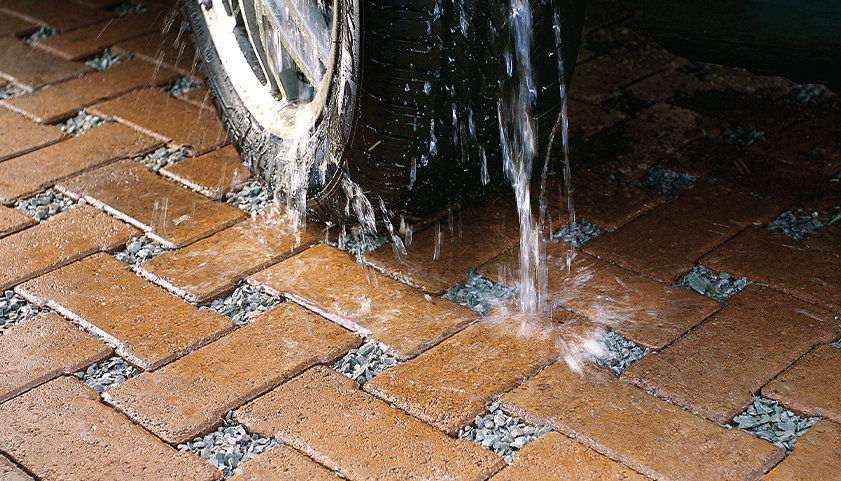Feature photo: Elfreth’s Alley, dating back to 1703, is the country’s oldest continually occupied residential street, located in the Old City neighborhood of Center City, Philadelphia, Pa. (Courtesy ElfrethAlley.org)
Maybe too long to read? … but worth your time if you love cobblestones like I do!
There is something magical about cobblestones. Walking on the natural, water-smoothed stones transports pedestrians back in time to a less complicated and more romantic time when the clip-clop of horseshoes echoed with each step and gaslight street lamps pushed back the night.
Cobblestones date back to ancient times, with many pre-Roman cobbled streets dating back to the 3rd and 4th centuries. They’ve been used worldwide throughout history—mainly in Europe but also in Latin America—and are still in use.
- What are Cobblestones?
- When Did Cobblestones Come to the US?
- Historical US Locations with Cobblestone Roads
- Cobblestone Historical Buildings in the US
- Cobblestone Pavers in the US Today
What are Cobblestones?
Cobblestones are a strong, natural material, originally collected from riverbeds where the flow of the water tumbling the stones made them round. “Cobble” comes from Ye Olde English word “cob,” meaning “rounded lump.”
When set in sand or bound with mortar, cobblestones proved to be perfect for paving roads. With the strength of cobblestone, no ruts from wagon wheels developed in the streets. The surface remained flexible, so it wouldn’t crack during freezes. The stones also wouldn’t easily crack due to any normal movement on the road. Cobblestones prevented a road from getting muddy when it rained or from getting dusty in dry weather. If a stone did need replacing for any reason, it was easily dug up and a new one put in its place.
When Did Cobblestones Come to the US?
Although imported from Europe, America also had its own source of cobblestones. In the Finger Lakes Region of New York State, the retreat of the glaciers during the last ice age left numerous small, rounded cobblestones available for streets and buildings. Pre-Civil War architecture in the region made heavy use of cobblestones for walls. Today, the fewer than 600 remaining cobblestone buildings are prized as historic locations, most of them private homes. Ninety percent of the cobblestone buildings in America can be found within a 75-mile radius of Rochester, New York.
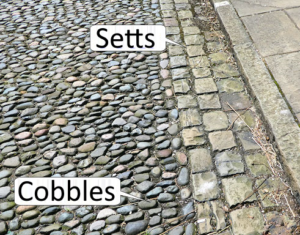 During the 17th century in New York, the city streets began to change from oyster shells and dirt roads to cobblestone streets. The original cobblestone streets used smooth, rounded stones but later the construction materials gave way to the quarried Belgian Blocks. Usually six to twelve inches in length and half that dimension wide, the blocks were laid out in a pattern on the roads. Most often granite, they could also be limestone or sandstone. Commonly referred to as setts, they had the advantage of being less punishing on the fragile carriage wheels of the day.
During the 17th century in New York, the city streets began to change from oyster shells and dirt roads to cobblestone streets. The original cobblestone streets used smooth, rounded stones but later the construction materials gave way to the quarried Belgian Blocks. Usually six to twelve inches in length and half that dimension wide, the blocks were laid out in a pattern on the roads. Most often granite, they could also be limestone or sandstone. Commonly referred to as setts, they had the advantage of being less punishing on the fragile carriage wheels of the day.
These days setts are commonly referred to as “cobbles” as well. Belgian Block setts were the primary construction material until the mid-19th century when concrete replaced cobbles and setts because it was cheaper to use. Most cobblestone roads were eventually updated with street builders pouring concrete over the cobblestones and setts, then later layering asphalt over the concrete.
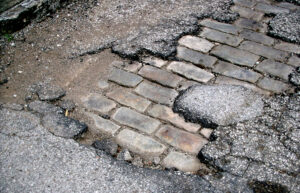
There is a restoration movement afoot in New York and many of the old cobblestones and Belgian Blocks streets are in the process of being restored. Where asphalt and concrete have broken from wear and tear over the last centuries, the restoration rules require that builders use the original material upon restoration.
Historical US Locations with Cobblestone Roads

Cobblestones were used extensively in the United States. In the 1800s, most cobblestones arrived on ships from Europe as ballast. The cobblestones were then configured into city roads. In the mid-1800s in Philadelphia, most of the city streets were cobblestone. Today, many older streets are still paved with cobblestones.
Several are in the northeast. In Philadelphia, Chestnut Street passes in front of Second Bank, modeled on the Parthenon and the archetype for many subsequent bank designs, This street is the epitome of pleasingly disordered cobblestones. Murray Hill Avenue, in Pittsburgh, Pennsylvania’s Squirrel Hill North neighborhood, is a a beautiful, residential, tree-lined cobblestone street lined with historic houses, and gardens. In Boston, you’ll find Acorn Street on Beacon Hill paved with antique cobblestone. It’s known as the most photographed street in the United States.
In the mid-west, Omaha, Nebraska, the Old Market district cobblestone streets date back to the late 1800s, when the area used to serve as a railroad center. Original cobblestones still pave Main Street in Minneapolis, Minnesota, the oldest street in that city.
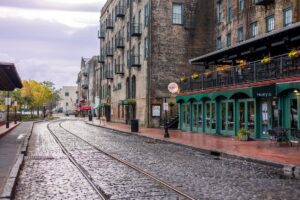
Famous preserved cobblestone streets are also found in the south. In Old Town Alexandria, Virginia, Captains’ Row is lined with old homes and cobblestone streets. By the late 18th century, more than ten miles of streets in the historic district of Charleston, South Carolina, were paved with the old cobblestones. In Savannah, Georgia, the 18th century Historic River Street running along the Savannah River is considered one of the most picturesque cobblestone streets in the United States.
Cobblestone Historical Buildings in the US
Historically, cobblestones were not only used for roads but for buildings as well. Cobblestones deposits were once found in the Finger Lakes region of New York and used in architecture before the Civil War. Many of the old cobblestone buildings still standing today are in or near Rochester, New York, where the style was prominent.

Most existing cobblestone buildings are now private homes, such as the Walling Cobblestone Tavern in Wayne County, New York. The two-story, gable-roofed tavern — built around 1834 from irregular, multicolored cobblestones — is now listed on the National Register of Historic Places. However, some public, cobblestone buildings do still exist today. In Wayne County, a historic one-room schoolhouse remains standing. Constructed of cobblestones in the early 1800s, the builders of the Roe Cobblestone Schoolhouse used the same type of cobblestones as used with the Walling Tavern. It’s now a schoolhouse museum, operated by the Butler Historical Society.
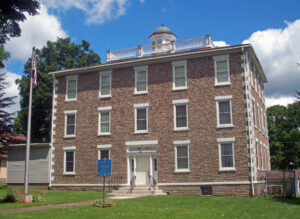
Another public cobblestone building is the Alexander Classical School in Alexander, New York. This three-story school was first erected in the 1830s with cobblestone. After being used for a variety of purposes throughout the years, it was finally remodeled in the 1990s, restoring it to its natural beauty with reclaimed cobblestone to keep its historic charm. The building now contains a museum.
Cobblestone Pavers in the US Today
In addition to the demand for cobblestone on restoration projects, antique cobblestone — aka vintage cobblestone and reclaimed cobblestone — are in great demand for construction projects for private residences. Most are reclaimed from old streets in turn-of-the-century mill towns and old seaports. Old cobblestones are often upcycled to pave driveways and construct fireplaces, walls, patios, walkways, or even buildings.
Reclaimed or used cobblestones uphold “green” building principles. Cobblestones set in sand have two environmental advantages. They are permeable paving allowing water to seep into the sand, and they move rather than crack on response to ground movement. Due to their green qualities, uniqueness and beauty, cobblestones are once again popular building materials.

